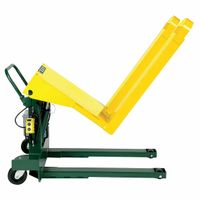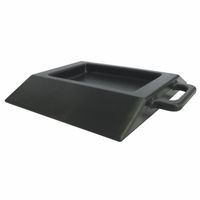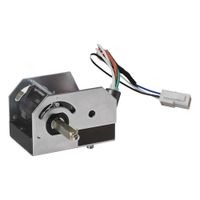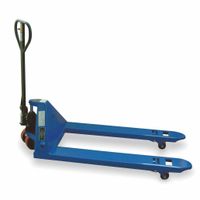Call +(254) 703 030 000 / 751 483 999 / 721 704 777
- Home
- Material Handling
- Transporting
- Pallet Jacks Container Tilters
.....Read More
Frequently Asked Questions
What is the difference between a pallet jack and a forklift?
A pallet jack and a forklift are both used for material handling, but they differ significantly in design, functionality, and capacity.
A pallet jack, also known as a pallet truck, is a simple, manually operated tool used to lift and move pallets within a warehouse or storage facility. It consists of a small frame with two forks that slide under a pallet. The operator manually pumps a handle to raise the pallet slightly off the ground, allowing it to be pushed or pulled to a new location. Pallet jacks are ideal for short distances and lighter loads, typically up to 5,500 pounds. They are cost-effective, require minimal training, and are suitable for tight spaces due to their compact size.
In contrast, a forklift is a powered industrial truck used for lifting and transporting heavier loads over greater distances. Forklifts come in various types, including electric, gas, and diesel-powered models, and can handle loads ranging from 3,000 to over 70,000 pounds. They feature a mast and hydraulic lifting system that allows for vertical lifting, making them suitable for stacking pallets at different heights. Forklifts are versatile, capable of operating indoors and outdoors, and can be equipped with various attachments for specialized tasks. However, they require more training and certification to operate safely.
In summary, the primary differences between a pallet jack and a forklift lie in their power source, load capacity, range of motion, and operational complexity. Pallet jacks are manual, limited to lighter loads and short distances, while forklifts are powered, capable of handling heavier loads, and offer greater versatility in material handling tasks.
How do you operate a pallet jack safely?
To operate a pallet jack safely, follow these steps:
1. **Inspection**: Before use, inspect the pallet jack for any damage or defects. Check the wheels, forks, handle, and hydraulic system to ensure they are in good working condition.
2. **Load Assessment**: Ensure the load is within the pallet jack's weight capacity. Distribute the weight evenly on the pallet to prevent tipping.
3. **Positioning**: Align the pallet jack with the pallet. Insert the forks completely under the pallet, ensuring they are centered and not protruding from the other side.
4. **Lifting**: Use the handle to pump the hydraulic system, raising the forks and the pallet off the ground. Lift only enough to clear the floor, minimizing the risk of instability.
5. **Maneuvering**: Push the pallet jack rather than pulling it, as pushing provides better control and reduces strain on the operator. Keep the load in front of you and maintain a clear line of sight.
6. **Speed Control**: Move at a controlled speed, especially when turning or navigating through tight spaces. Avoid sudden stops or changes in direction.
7. **Pathway Check**: Ensure the path is clear of obstacles, debris, or wet surfaces that could cause slipping or tripping.
8. **Inclines and Declines**: When moving on inclines, keep the load uphill to prevent it from rolling back. On declines, maintain control and avoid letting the load gain too much speed.
9. **Lowering the Load**: Once at the destination, slowly lower the load by releasing the hydraulic pressure. Ensure the pallet is stable before removing the forks.
10. **Storage**: After use, store the pallet jack in a designated area, ensuring it does not obstruct walkways or emergency exits.
By following these guidelines, you can operate a pallet jack safely and efficiently.
What are the weight limits for pallet jacks?
Pallet jacks, also known as pallet trucks, are essential tools in warehouses and distribution centers for moving pallets. The weight limits for pallet jacks vary based on their design and type. Manual pallet jacks typically have a weight capacity ranging from 5,000 to 5,500 pounds (approximately 2,268 to 2,495 kilograms). These are the most common and are operated by hand, suitable for lighter loads and shorter distances.
Electric pallet jacks, which are powered and often used for heavier loads and longer distances, generally have a higher weight capacity. They can handle loads between 4,500 to 6,000 pounds (about 2,041 to 2,722 kilograms). Some heavy-duty models can even support up to 8,000 pounds (approximately 3,629 kilograms).
Specialized pallet jacks, such as high-lift or scissor lift pallet jacks, have different weight limits due to their unique design. These are typically used for lifting pallets to a higher height and may have lower weight capacities, often around 2,200 to 3,300 pounds (approximately 998 to 1,497 kilograms).
It's crucial to adhere to the manufacturer's specified weight limits to ensure safety and prevent damage to the pallet jack and the goods being transported. Overloading a pallet jack can lead to mechanical failure, accidents, and potential injury to operators. Always check the specific model's manual or manufacturer's guidelines for precise weight capacity information.
How do you maintain a pallet jack?
To maintain a pallet jack, follow these steps:
1. **Regular Inspection**: Check for visible damage or wear on the forks, handle, and wheels. Ensure the frame is not bent or cracked.
2. **Lubrication**: Apply grease to the grease fittings on the wheels and pivot points to ensure smooth operation. Use a high-quality lubricant suitable for the environment.
3. **Hydraulic System**: Inspect the hydraulic system for leaks. Check the hydraulic oil level and top up if necessary with the recommended oil type. Bleed the system to remove air if the jack is not lifting properly.
4. **Wheels and Rollers**: Examine wheels and rollers for wear or damage. Replace them if they are cracked or excessively worn to ensure smooth movement and prevent damage to floors.
5. **Forks**: Ensure the forks are straight and not bent. Check for cracks or other damage. Verify that the fork tips are not worn down, which can affect lifting capability.
6. **Handle and Controls**: Test the handle and controls for proper operation. Ensure the release lever functions smoothly and the handle returns to the upright position when released.
7. **Brakes**: If equipped, check the brakes for proper function. Adjust or replace them if they are not holding the jack in place when engaged.
8. **Cleaning**: Keep the pallet jack clean by removing dirt, debris, and any corrosive substances. This helps prevent rust and ensures all parts function correctly.
9. **Storage**: Store the pallet jack in a dry, clean area to prevent rust and damage. Avoid leaving it under heavy loads for extended periods.
10. **Training**: Ensure operators are trained in proper use and maintenance procedures to prevent misuse and extend the lifespan of the pallet jack.
What are the benefits of using a container tilter?
A container tilter offers several benefits that enhance efficiency, safety, and ergonomics in material handling processes:
1. **Improved Ergonomics**: By tilting containers to an optimal angle, workers can access contents without bending or stretching, reducing the risk of musculoskeletal injuries and improving comfort.
2. **Increased Efficiency**: Tilting containers allows for quicker and easier access to materials, speeding up loading and unloading processes. This can lead to increased productivity and reduced downtime.
3. **Enhanced Safety**: Container tilters minimize the need for manual lifting and awkward postures, reducing the likelihood of workplace accidents and injuries. This contributes to a safer working environment.
4. **Reduced Material Damage**: By providing a controlled method of accessing contents, container tilters help prevent spillage and damage to materials, ensuring product integrity and reducing waste.
5. **Versatility**: Container tilters can handle various container sizes and types, making them suitable for diverse applications across industries such as manufacturing, warehousing, and logistics.
6. **Cost Savings**: By improving efficiency and reducing injury-related costs, container tilters can lead to significant cost savings over time. They also help in minimizing product damage, further contributing to cost efficiency.
7. **Space Optimization**: By facilitating better organization and access to materials, container tilters can help optimize workspace, allowing for more efficient use of available space.
8. **Ease of Use**: Most container tilters are designed for easy operation, often requiring minimal training, which can lead to quicker implementation and adoption in the workplace.
9. **Durability and Reliability**: Built to withstand heavy use, container tilters are typically robust and reliable, ensuring long-term performance and reducing the need for frequent maintenance or replacement.
How do you choose the right pallet jack for your needs?
To choose the right pallet jack, consider the following factors:
1. **Load Capacity**: Determine the maximum weight you need to lift. Standard pallet jacks typically handle up to 5,500 lbs, but heavy-duty models can support more.
2. **Fork Length and Width**: Match the fork dimensions to the size of the pallets you use. Standard forks are about 48 inches long, but shorter or longer options are available for different pallet sizes.
3. **Lift Height**: Consider the height to which you need to lift pallets. Standard models lift up to 7 inches, but high-lift jacks can reach higher.
4. **Material and Environment**: Choose materials based on the environment. Stainless steel or galvanized jacks are ideal for wet or corrosive environments, while standard steel is suitable for dry areas.
5. **Type of Pallet Jack**:
- **Manual**: Cost-effective and suitable for light to moderate use.
- **Electric**: Easier to operate, ideal for frequent or heavy lifting.
- **Rough Terrain**: Designed for uneven surfaces, useful in outdoor or construction settings.
6. **Maneuverability**: Consider the turning radius and ease of use in tight spaces. Compact models are better for narrow aisles.
7. **Ergonomics**: Look for features like ergonomic handles and easy-to-use controls to reduce operator fatigue.
8. **Budget**: Balance your needs with your budget. While electric models are more expensive, they offer efficiency and ease of use.
9. **Brand and Warranty**: Choose reputable brands that offer good customer support and warranty options for peace of mind.
10. **Safety Features**: Look for features like brakes, overload protection, and safety stops to ensure safe operation.
Evaluate these factors based on your specific operational needs to select the most suitable pallet jack.
Can pallet jacks be used on uneven surfaces?
Pallet jacks are primarily designed for use on smooth, flat surfaces such as warehouse floors. They can be challenging to operate on uneven surfaces due to their small wheels and lack of suspension. On uneven surfaces, pallet jacks may become difficult to maneuver, and the load can become unstable, increasing the risk of accidents or damage to the goods being transported.
The small wheels of a standard pallet jack can get caught in cracks or gaps, making it hard to push or pull the load. Additionally, uneven surfaces can cause the pallet jack to tilt, which may lead to the load shifting or falling. This instability can pose safety risks to the operator and others nearby.
However, there are specialized pallet jacks designed for rough terrain or uneven surfaces. These models typically feature larger, pneumatic tires that can better handle bumps and irregularities. They may also have enhanced suspension systems to provide more stability and control. While these rough terrain pallet jacks are more suitable for uneven surfaces, they are generally more expensive and may not be as readily available as standard models.
In summary, while standard pallet jacks are not ideal for uneven surfaces, specialized models can be used effectively in such conditions. It is crucial to assess the specific requirements of the environment and choose the appropriate equipment to ensure safety and efficiency.



